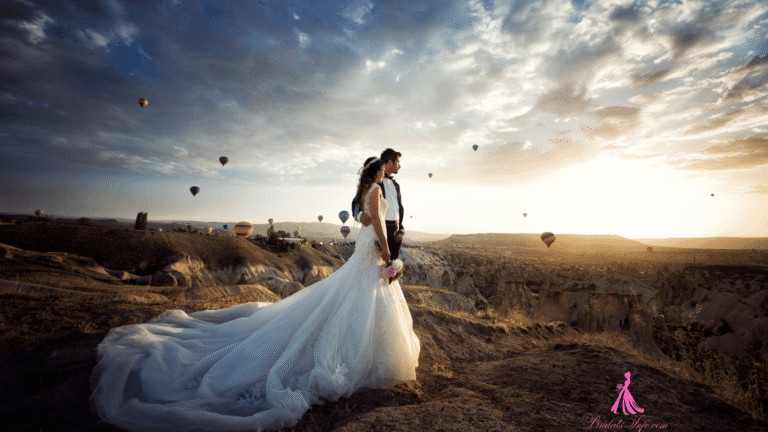Creating a micro-wedding schedule for fewer than 20 guests is about doing what really counts, not about doing less. Intimate ceremonies that prioritize emotion, intentionality, and sincere connection have become more and more popular among couples in recent years. This change provides a novel perspective on contemporary marriage and is remarkably successful in removing logistical stress. Celebrities such as Joe Jonas and Zoë Kravitz have subtly embraced the intimacy of these smaller affairs, establishing a potent trend that speaks to a deeper yearning for genuineness.
Instead of rushing through an itinerary, the timeline becomes a chance to relax, connect, and savor every moment by concentrating on fewer guests. Set aside 90 minutes for preparation, which is the first step in creating a highly effective structure. Imagine having coffee while wearing silk robes, laughing while listening to music, and having your photographer capture special moments. Many brides used their childhood bedrooms as prep areas during the pandemic, which added a sentimental element that is now reflected in microwedding trends.
Key Elements for Planning a Magical Micro-Wedding Timeline (Under 20 Guests)
| Feature | Description |
|---|---|
| Ideal Guest Count | 15 to 20 close friends or family members |
| Duration of Celebration | Typically spans 6 to 8 hours, depending on planned activities |
| Suggested Ceremony Time | Late afternoon to align with golden hour for photography |
| Venue Options | Private homes, luxury rentals, gardens, mountaintops, or boutique venues |
| Average Budget Range | $5,000–$20,000, based on location, vendors, and experience choices |
| Key Vendors to Prioritize | Photographer, planner, officiant, private chef or caterer, and floral designer |
| Planning Tools | Google Docs for collaboration, Zola or The Knot for event scheduling |
| Popular Add-Ons | Signature cocktails, personalized vows, group activities like bonfires or toasts |
| Trend Influences | Zoë Kravitz, Lily Allen, and Gwyneth Paltrow opting for private, guest-limited celebrations |
| Timeline Impact | Allows more emotion-filled moments and fewer logistical complications compared to large events |
The first look follows, and it ought to be planned for at least half an hour prior to the ceremony. This private conversation serves as emotional grounding in addition to aesthetic purposes. You can greatly reduce your pre-ceremony anxiety and give your photographer more time to capture the silent tension and joy between you by scheduling this moment earlier. When surrounded by a stunning setting, this moment often becomes more memorable for many couples than the actual ceremony.
The ceremony ought to unfold organically, preferably within 30 minutes of the initial glance. Select a time when the late afternoon golden light is present, which is very flattering and ideal for portraiture. Keep the ceremony brief—20 to 30 minutes is plenty—and personal. Some couples add special touches, such as reading poetry together or blending sand. Even though Lily Allen’s vows to David Harbour under the Las Vegas skyline in 2023 lasted less than fifteen minutes, they had a profound emotional impact.
It is ideal to set aside 15 to 30 minutes for group photos following the ceremony. Compared to traditional weddings, this process is significantly simpler and much less stressful when the guest list is small. Make a list of the necessary combinations beforehand. With fewer distractions and more precise guidance, you’ll be shocked at how easily this section goes.
Dinner quickly takes over as the day’s next emotional fulcrum. Set aside 90 minutes for the meal, whether it is being served in a candlelit villa or under bistro lights. This part of the day is so adaptable that it can be used for spontaneous dancing, stories, laughter, and toasts. The culinary experience is frequently improved when there are fewer guests present; many couples hire private chefs or provide tasting menus that highlight regional cuisine.
Setting up sunset portraits during or shortly after dinner is a particularly useful tactic. Set aside thirty to forty-five minutes to sneak away with your photographer. The photographs taken in soft light, usually on peaceful walks or cliffside overlooks, are the ones that will hang above your fireplace for decades. This window yields the most emotionally charged images, according to photographers throughout Montana and coastal California.
Always leave room for flexibility to keep the day moving. Timelines change even with the best preparation. Include 10-minute breaks in between activities. These cushions enable last-minute adjustments, impromptu toasts, or just quiet time spent holding hands. These short breaks keep the experience grounded and joyful while also significantly lowering stress.
Effective communication is essential throughout the day. Distribute the final schedule to family members, vendors, and other participants. Keeping everyone in sync is ensured by using tools like Google Docs. For instance, there were no interruptions to the timeline when a newlywed couple at an Oregon vineyard used a color-coded spreadsheet that synchronized via cloud.
Additionally, weather should be taken into account, especially for outdoor venues. Bring comfortable blankets, personalized shawls, or chic umbrellas. These products have two functions: comfort and style. Instead of being a crisis, unexpected rain or a cold wind becomes a part of the narrative. As planners frequently say, “Rain softens micro weddings, not destroys them.”
One unique emotional texture that microweddings provide is rare. Couples can prolong moments that might otherwise be hazy thanks to them. Every element, including the music and menu, feels deliberate thanks to the careful pacing and carefully chosen experiences. This structure, which is noticeably better than traditional weddings, allows more time for genuine connection rather than merely courteous interactions.
In the Hudson Valley, for instance, a bride invited only 12 people and planned a bonfire after dinner where each person shared a memory of the couple. No DJ. Don’t throw the bouquet. Red wine, honest words, and warm light. A micro-wedding timeline allows for these kinds of experiences.
Last piece of advice: work with suppliers who are familiar with small-scale magic. The subtle beauty of shared glances and quiet laughter may be lost on a photographer used to 300-guest galas. Look for people who specialize in intimacy—who understand that a grandmother’s silent smile or a single tear can convey a whole story.
The shift in the industry toward smaller ceremonies is not just a passing fad. It’s a cultural adjustment. Couples are choosing introspection over luxury and connection over crowd size. Unquestionably rich in meaning, this approach is surprisingly affordable for many.

